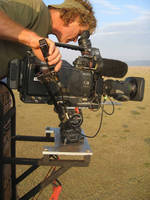DP BOB Poole Captures Dramatic Footage in Africa for "Great Migrations" with Fujinon HD Lenses

WAYNE, N.J. - As a principal cinematographer on four episodes of the acclaimed National Geographic series, "Great Migrations," Bob Poole, www.poolefilms.com, captured intimate close-ups of Mali's desert elephants - a remote and dangerous herd that were difficult to film. And in war-torn Southern Sudan, tense battles between male white-eared kob (antelopes) that often fight to the death for the right to breed. "Great Migrations" is the largest endeavor in National Geographic's 122-year history, and Poole was provided the time and resources to capture images that otherwise would be impossible.
Poole used two Fujinon lenses to capture all of his "Great Migrations" footage - a HA25X11.5BERD HD lightweight telephoto lens and a HA13x4.5BRD HD wide angle ENG-Style lens. When the winds were particularly heavy, Poole often employed his TS-P58 image stabilizer from Fujinon.
"Great Migrations tells life and death stories about individual animals within the migrating herds, and proximity makes good pictures," explained Poole. "Mali elephants are terrified of vehicles, so all my filming had to be done on foot and without them knowing I was there. I needed to get as close as possible, but it was too dangerous to use anything other than a long lens, except for wide shots and scenics. Between my two lenses, I had the full range covered."
"When shooting wildlife you have to capture behavior as it's happening. In the past I used a telephoto prime, and it was difficult to train the lens on the action in time. Now, with the 25x, I can zoom out to find the subject and quickly bring it back to a close- up. If I'm set up, balanced and level, I don't miss important moments of behavior anymore."
According to Poole, the HA25x11.5BERD telephoto lens compresses distance in a way that provides greater impact to the visuals. "The lens has a close focus and works nicely for macro shots. I can fill the frame with an ant, or with the head of a poisonous snake without getting dangerously close."
Poole appreciates the durability of the Fujinon lenses when working in the far corners of the world in less than ideal weather conditions. While in Mali, Poole and his colleague, John Mans, found themselves in the middle a massive sandstorm. (To see video of the event, click on: www.poolefilms.com/great_migrations/gm.html.)
The environmental conditions in Mali were the most challenging of Poole's career. He experienced extreme temperatures of 125F in the shade, and wind blowing sand and dust. However, the most extreme condition was the sandstorm. The HA13.4.5 wide-angle lens was able to capture the incredible size of the oncoming sandstorm against the landscape, while the HA25x11.5BERD telephoto lens showed the speed that it was moving. "My camera covers saved the equipment, even though sand and dust were in everything the lenses lived to shoot another day." "That's why you buy a professional lens," said Poole. "It's designed and made so well that it can handle the most extreme situations."
The lenses were paired with a Sony HDW-F900 HDCAM camcorder for the first half of the two-and-a-half year project, and Poole later changed to a Sony PDW-700 XDCAM.
Poole's work can be seen in the first episode of "Great Migrations," titled "Need to Feed;" which features the wildebeest migration in Kenya and Tanzania, in the second episode, "Need to Breed" which follows white-eared kob in Sudan, and in the fourth episode, "Feast of Famine" about the Mali elephant migration. He shot principal cinematography on the special segment "The Science of Migrations" and was featured in "The Making of Great Migrations."
"Great Migrations" premiered on the National Geographic Channel on November 7, 2010.
About FUJIFILM Optical Devices U.S.A., Inc.
FUJIFILM Optical Devices U.S.A., Inc. is a major manufacturer and distributor of optics and lens assemblies for the broadcast, digital cinema and industrial markets. The company's line of television zoom lenses are used in virtually every segment of the broadcast industry, including electronic newsgathering, studio and field production, and high definition television. For more information about FUJIFILM broadcast and communications products, call (973) 633-5600 or visit our web site at www.fujinonbroadcast.com.
FUJIFILM Optical Devices U.S.A., Inc.,
10 High Point Drive,
Wayne,
New Jersey 07470.
Phone: 973-633-5600.
Fax: 973-633-5216.
Web site: fujinon.com.
Press Contact:
Robin Hoffman
Pipeline Communications
(973) 746-6970
e-mail: robinhoffman@pipecomm.com




